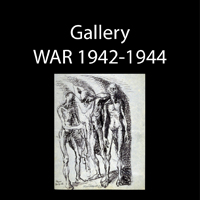
These frescos, « It was like a challenge to the jailer of Vichy! » In the barrack 6, for example, he painted a barricade of insurgents, with the verses : «
Beyond the shootings Liberty awaits us
, falsely attributed to Paul Vaillant-Couturier (died 10 October 1937). These words are taken from a revolutionary Russian song : « Hardy comrades », written in 1897. In reaction to the insolent speech of the South African marshal Smuts, who proclaimed that France had no future, Boris began painting« an answer to this silly statement".»
It was
the picture of a woman wearing a Phrygian cap, symbol of France
, spreading on the world these French glories, from the name of Vercingetorix, until those of the contemporary heroes, Peri, Timbaud, Estienne d'Orves, Danielle Casanova, and all the marshals of France, Joffre, Foch, Lyautey, and all the great revolutionaries, Robespierre, Marat, Saint-Just, the Communards, and the great writers, artists and scientists who marked the immense history of the Nation, uninterrupted. »(8)
« Then, other resistants of different obedience other than Communists came to find me and asked me: "Will you decorate the chapel?" I answer, "Yes, of course, but I have one condition: Ask the chaplain to get me some colors." And that's what they did. The chaplain asked Monseigneur Salieges, Archbishop of Toulouse, to send me five boxes of paints in the building: a blue, red, yellow, black and white one. With all those colours, I painted it. »
The chapel fresco
represents, on a background of tricolor sky, the painful picture of a Christ standing before his cross, with his hands bound, between an old woman of the people and a man bald and skinny, in rags and hoofs, bearing on his face an expression of anguish and pity. Above the head of Christ, on a crown of thorns, stands a dove. Boris makes of this Christ the symbol of the resistant man fighting for the liberation of France, sharing the pain of the people.
« I drew Jesus in a blanket with the letters SN (National Security) like on the clothes of the prisoners. The crown on his head is not made of thorns but barbed wire. Mary, on her right is a simple woman, of the people, and to her left we can see Joseph wearing rags. With a three-coloured sky... » (9)
This fresco was at the origin of a fraternal understanding between « those who believed in heaven and those who didn't. » The Communist artist argued that it helped that as a result of this, more people joined the National Front for the Liberation of France.
(5) The Groupes mobiles de réserve (Mobile Reserve Groups, often abbreviated to GMR, were the paramilitary units created by the Vichy government.
(6) "The Master of Saint-Sulpice", in Regard, n°2, February 1945.
(7) "Barracke 5", Boris Taslitzky, in La Nouvelle Critique (The new Review, n°4, March 1949, p.32.
(8) "The Master of Saint-Sulpice", in Faites entrer l'infini (Enter infinity), n°17, June 1994, p. 5.
(9) Pnina Rosenberg, The Art of Undesirables. Art in French internment camps 1939-1944, l'Harmattan, 2003, p. 172.
(6) "The Master of Saint-Sulpice", in Regard, n°2, February 1945.
(7) "Barracke 5", Boris Taslitzky, in La Nouvelle Critique (The new Review, n°4, March 1949, p.32.
(8) "The Master of Saint-Sulpice", in Faites entrer l'infini (Enter infinity), n°17, June 1994, p. 5.
(9) Pnina Rosenberg, The Art of Undesirables. Art in French internment camps 1939-1944, l'Harmattan, 2003, p. 172.
Jacky TRONEL
Useful link : Jacky TRONEL' blog about the Riom prison and Saint-Sulpice-la-Pointe Camp.
